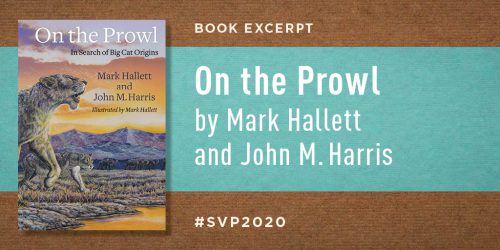Q&A: Mark Hallett and John M. Harris on On the Prowl: In Search of Big Cat Origins

“On the Prowl brings together biological and paleontological research related to the origins and history of the big cats, with an original emphasis on Asiatic data, paying homage to their majesty, dignity, and beauty. Mark Hallett’s artwork has succeeded brilliantly in capturing their inner spirit and character, their vulnerability and vitality. This book will serve the noble goals of making people aware of the fragility of ecosystems and revealing the moral obligation to preserve and protect extant species.”
~Christine Argot, research professor and curator of collections, Muséum national d’histoire naturelle, Paris
The hit Neftlix series Tiger King has reinvigorated the fascination of many people with big cats. Yet these exotic creatures, which capture imaginations worldwide, may not be around for future generations. In today’s Q&A, Mark Hallett and John M. Harris discuss the plight of big cats and their new book, On the Prowl: In Search of Big Cat Origins.
If you enjoy the Q&A, be sure to enter this week’s drawing for a chance to win a copy of the book!
• • • • • •
Q: What is this book about?
Mark Hallett and John M. Harris: Nourished by wildlife programs, zoos, picture books, and stuffed toys, many people grow up with the idea that somewhere on the dry subtropical plains and in the humid jungles of Africa, Asia, and South America there live populations of lions, tigers, leopards, and jaguars that both thrill and terrify us with their fierce, magnificent beauty. If those who do not live there are fortunate and can someday travel and see these iconic animals in their native lands—it’s the experience of a lifetime.
Yet in our own lifetimes and by the end of the twenty-first century, the pantherins, or big cats, may totally vanish from the wild, surviving for our children and grandchildren only in zoos. This was the fate of the northern white rhino, of which two captive, aging females are the only living members of a species that once numbered in the thousands but was slaughtered through human greed to profit from their horns. This species is sadly now considered functionally extinct, having been exterminated within the past few decades after surviving on earth for millions of years.
On the Prowl: In Search of Big Cat Origins takes readers on the long, eventful journey through geologic time from when the big cats’ ancestors were small, tree-living predators, tracing the ancestry, past ecology, and lost relatives of the genus Panthera and its extinct kin across the continents and ending with a strategy for saving the modern big cats from extinction in the time we have left.
Q: What kinds of readers would enjoy the book?
MH & JMH: This book is fascinating, highly informative reading for anyone who loves and wants to know more about cats, big or small, ancient or modern. Checked for accuracy by leading wildlife biologists such as George B. Schaller, the anatomical and behavioral adaptations that make cats such remarkable hunters are summarized, setting the stage for tracing the path that ancestral cats, sometimes foiled by awesome prehistoric competitors, took to become the dominant predators of later geologic times. Until recently the evolution of big cats has been poorly understood. The book provides a detailed, up-to-date account of how ancient ecosystems and prey species determined the course of big cat evolution, ending with the fateful encounter with humans during the last ice age and the evidence from cave art and sculpture, of how these animals became objects of veneration and awe. Our readers will receive a detailed accounting of how this relationship then declined, beginning in the ancient world and through the exploitation by later human cultures. We present the systematic way in which each species of living (and recently extinct) pantherin historically declined over the centuries from human activities, culminating in the trade in cat body parts that still continues in some countries. And we present solutions for conservation.
Q: Does the book contain any new or novel ideas?
MH & JMH: A new hypothesis advanced by the authors in chapter 3, “A Breath of Frost” is that the big cats had their evolutionary origins on the Tibetan Plateau: two early characteristics of pantherins, increases in vertical agility and body size, were direct evolutionary responses to the requirement of overcoming correspondingly greater size and agility in their mountain-adapted prey, the rupicaprins and caprin (chamois, goats, and sheep).
Q: Does the book present current solutions for the problem of protecting big cats?
MH & JMH: A point-by-point assessment of the main problems facing the big cats is answered by realistic socioeconomic solutions such as the integration of local human societies through their financial benefit into conservation plans and the establishment of wildlife corridors in key parts of the cats’ environments. Political issues relating to pantherin conservation are openly and directly dealt with, such as the continuing operation of “tiger farms” in China and other Southeast Asian nations and the overall trade in feline body parts. A special section, “Taking Action,” directs readers to current wildlife organizations that they can aid in protecting big cats.
Q: Does the book offer illustrations?
MH & JMH: The book has more than138 figures and photos. On the Prowl: In Search of Big Cat Origins is heavily illustrated with new, detailed, and extremely accurate reconstructions of fossil cat skeletons and life restorations, both color and black and white, as well as many photos dealing with historic and contemporary aspects of human-pantherin history and big cat conservation.
Q: What is the book’s value as a reference tool?
MH & JMH: In addition to the wealth of figures depicting fossil and modern cats, the book contains an extensive glossary and illustrated appendices showing felid evolution, geographic distribution, and known fossil and modern species, making it a valuable reference for paleontologists, zoologists, wildlife conservationists, and school libraries.



